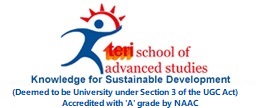
ANNOUNCEMENTS

| Date | News Title | Source |
| 18-July-2025 | 1 in 4 Indian married couples ... | The Indian Express |
| 23-June-2025 | Blended Learning: Driving educ... | The Pioneer |
| 22-June-2025 | All adults overweight in every... | |
| 21-June-2025 | TERI SAS Nurturing Global Sust... | The Interview World (Online) |
| 27-May-2025 | Eco-education trend grows: Sus... | India Today (Online- Education Desk) |
| 25-March-2025 | How water green credits can fu... | Hindustan Times (Opinion) |
| 23-February-2025 | Sustainable biz practices disc... | The Times of India (Online) |
| 21-February-2025 | Sangam fit for bath’, Enviro... | News9 (Online) |
| 12-February-2025 | A role for India in South-Sout... | The Hindu (Online) |
| 02-December-2024 | ICAR Findings Show 34% Decline... | ETV Bharat (Online) |
India can position itself as a leader in the global transition to a low carbon pathway, through transparent processes and equitable partnerships
Shubhi Goel ,Gopal K. Sarangi
‘Article 6.2 may foster such partnerships beyond the traditional North-South dynamic, enabling India to lead South-South cooperation’ | Photo Credit: Getty Images/iStockphoto
COP29, at Baku, Azerbaijan, aptly referred to as the ‘Climate Finance COP,’ has played a crucial role in operationalising core elements of Article 6 of the Paris Agreement (PA). The adoption of Article 6 at Baku represents a renewed focus on the market mechanism which could help countries that are often constrained by limited resources and face difficulties in achieving an economy-wide transition to a carbon-neutral economy.
Article 6 has the potential to meet climate ambitions through cooperative approaches. Its key component, Article 6.2, facilitates the transfer of Internationally Transferred Mitigation Outcomes (ITMOs) between host and partner country to help countries meet their Nationally Determined Contributions (NDCs), by offering flexibility for tailored agreements. The process not only supports emissions reductions in the host country (developing country) but also fosters technology exchange, promotes capacity building, and facilitates financial resources from the partner country (developed country), helping in the transition to a low-carbon economy and reaching the Sustainable Development Goals (SDGs).
Article 6.2 and India’s climate policies
India, which is considered to the third largest emitter of greenhouse gases (GHG), though in absolute terms only, and a rapidly growing economy, is well-positioned to draw benefits from Article 6.2. The country has had a challenge in balancing its developmental goals with its climate commitments due to a lack of adequate finance and also a lack of support from developed countries. India’s NDCs, inter alia, include ambitious targets, such as reducing emissions intensity by 45% by 2030. However, the financial and technical constraints are considerable, as just before COP29, India reiterated its call for the developed nations to mobilise at least $1 trillion annually in climate finance for developing countries to meet the challenges of global warming.
It is an opportune time for India as it moves to its own domestic emissions trading scheme (ETS), launched as a Carbon Credit Trading Scheme (CCTS) in 2023, with the aim of integrating market mechanisms into national policy. While not directly linked to Article 6.2, the CCTS proposes to strengthen India’s institutions by providing a framework for transparent carbon credit tracking and verification. India’s prior experience with the Clean Development Mechanism (CDM), voluntary carbon market (VCM), Energy Saving Certificates (ESCerts) and Renewable Energy Certificates (REC), has laid the groundwork for effective engagement with international carbon markets under Article 6.2, unlocking opportunities for emission reduction projects and climate finance.
India has identified 14 key activities for international collaboration under Article 6.2, which include Renewable Energy (RE), energy storage, and Carbon Capture, Utilization, and Storage programme. These technologies, such as green hydrogen and sustainable aviation fuel, require advanced expertise, research and significant investment, which India seeks through partnerships with leading nations such as South Korea, the European Union, and Japan.
Engaging in ITMO transactions under Article 6.2 gives India the opportunity to meet its SDGs by transferring surplus emissions reductions certificates to partner countries through different unique project implementations. There are also co-benefits such as reducing health problems and enhancing income through green jobs. On other hand, by encouraging South-South cooperation India can also generate ITMOs while facilitating investments in key sectors, in which India has extensive experience such as RE and sustainable infrastructure.
Opportunities for the country
Article 6.2 offers India an opportunity to unlock large-scale climate finance through South-South cooperation. Countries under pressure to meet stringent NDCs can purchase ITMOs from India, generating financial resources for climate-resilient projects and green technology development. For example, India’s renewable energy sector attracted over $10 billion in foreign direct investment in 2022. Further, ITMO transactions could scale up these efforts for other developing countries. The New Collective Quantified Goal (NCQG) also encourages such South-South cooperation as developing countries have been extending climate finance to other developing countries on a voluntary basis; however, their contributions are often unreported. Hence, Article 6.2 may foster such partnerships beyond the traditional North-South dynamic, enabling India to lead South-South cooperation, through the transfer of technology, and building capacity in developing countries (Africa) to help them meet their NDCs.
While India signs memorandums of understanding with developed countries to facilitate ITMO transfers, there is also a strong case for India to focus on building partnerships with African nations (India as partner country and Africa as host country). Africa, with its vast renewable energy potential and urgent climate vulnerabilities, is ideal for South-South cooperation. Many African nations face severe impacts from climate change, particularly in agriculture and water resources. India’s close partnership with African governments, extending to trade, investment, and developmental projects, strengthens this case. Under the 10 principles for India-Africa engagement enunciated by Prime Minister Narendra Modi, a key pillar is economic cooperation — emphasising sustained engagement, creating local capabilities, enhancing agricultural productivity, and addressing climate change. With its expertise in RE deployment, digital tools, and sustainable agriculture, India is well-positioned to help the region. This can also help India meet its NDCs while also accessing carbon market opportunities to fund sustainable development projects across the African continent.
The sharing of ITMOs between India and partner countries will depend on agreement specifics, reflecting India’s role as the host country and the developed partner’s contributions to technology and capacity building, which are also aligned with the Common but Differentiated Responsibilities and Respective Capabilities (CBDR-RC). The share ratio may vary based on each party’s contributions — India could claim a larger share if it extends significant financial or technical inputs. A similar approach is seen in the Joint Crediting Mechanism (JCM), where credit allocation is decided through mutual consultation based on contributions to GHG reductions. Japan typically offers technology, funding, and capacity building, while the host country implements the project. The JCM Joint Committee reviews and issues credits, ensuring transparency by publicly sharing allocation details.
The challenges
ITMO sharing offers opportunities for international cooperation. But, at the same time, it also presents challenges for India. Developed nations might rely on low-cost emission reductions from India, potentially avoiding significant domestic decarbonisation efforts and shifting costly mitigation burdens onto India. For India, ITMO transfers could involve opportunity costs, as these reductions might otherwise support its own climate targets or sustainability goals.
Additionally, inadequate transparency and governance in ITMO mechanisms may lead to inefficiencies and can accentuate inequities, affecting India’s interests. Over-reliance on ITMO transfers by partner nations could also hinder India’s broader priorities, such as capacity building, green technology deployment, and climate-aligned economic growth. To address these risks, India must ensure ITMO agreements include safeguards for equitable benefit-sharing, transparency, and alignment with national and global climate ambitions.
Shubhi Goel is a climate finance expert, consultant and freelancer. Gopal K. Sarangi is Associate Professor and Head of the Department, TERI School of Advanced Studies, New Delhi
Plot No. 10, Institutional Area, Vasant Kunj, New Delhi - 110 070, India.
Tel. +91 11 71800222 (25 lines).
Website : www.terisas.ac.in
Email id : registrar@terisas.ac.in
© Copyright © 2025, TERI SAS, All rights reserved.
Visitors No.: 46451305 Since 2023


